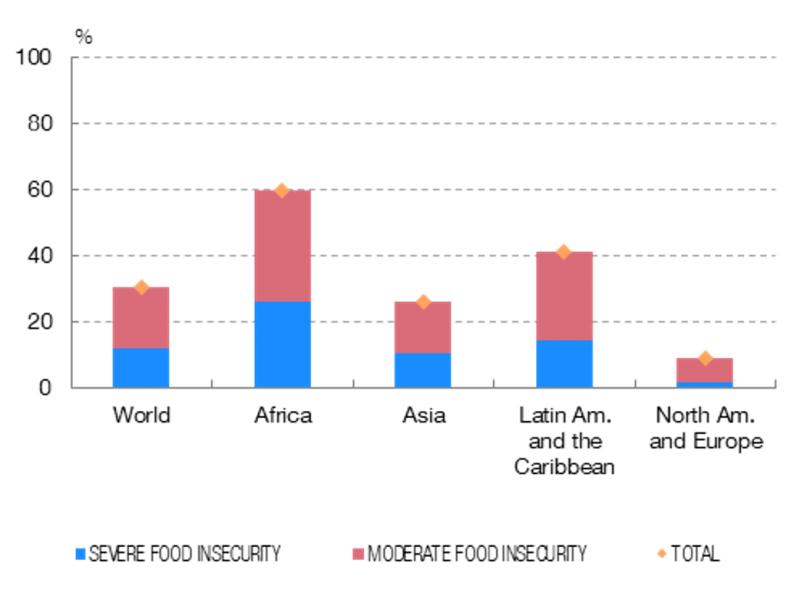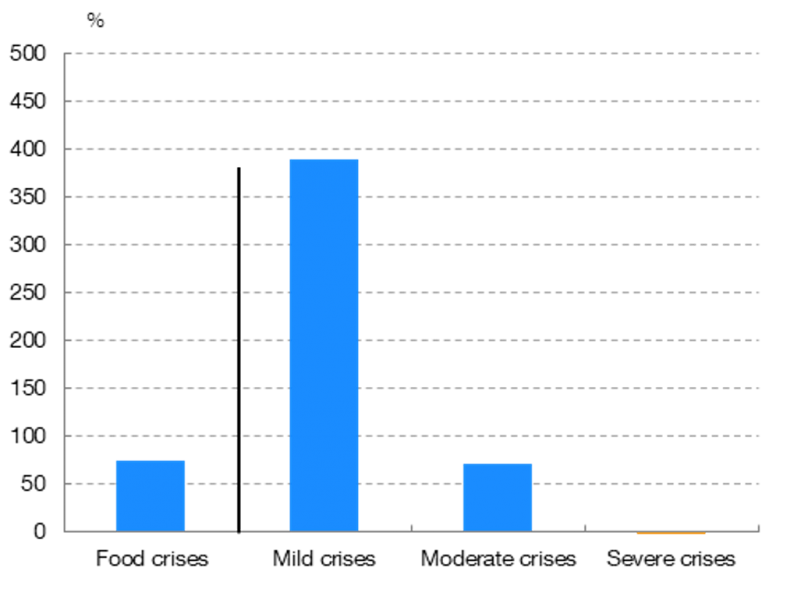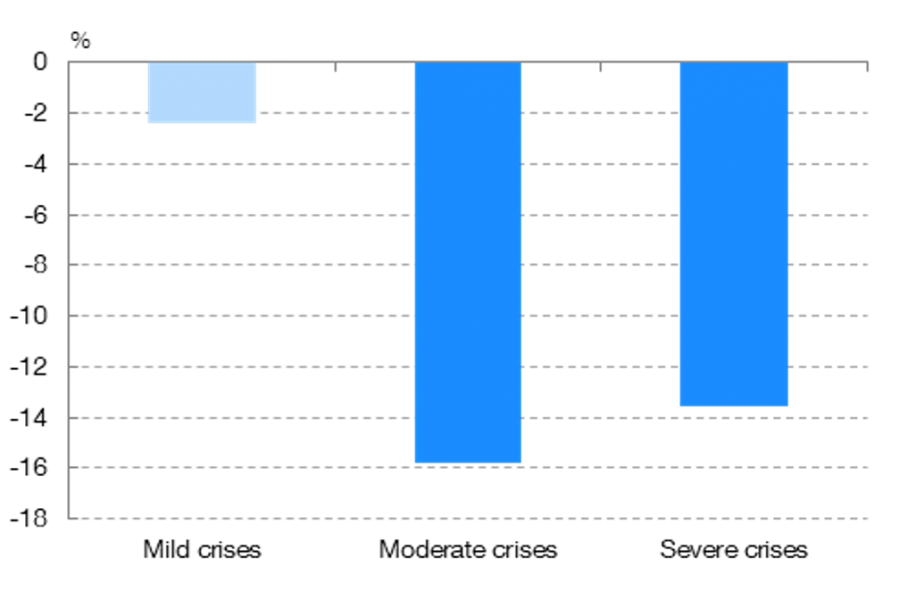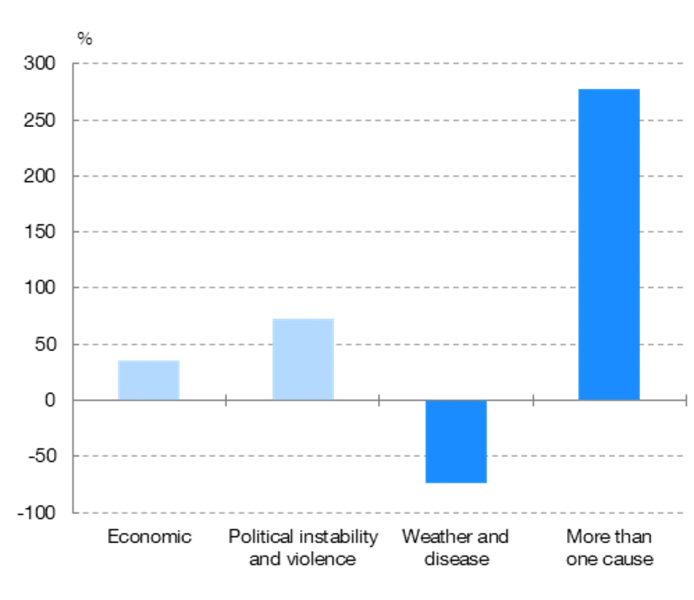

The views expressed in this paper are those of the authors alone and do not necessarily reflect the views of the Banco de España or Eurosystem.
There is growing concern about the emergence of a global food crisis, but little is known about its economic outreach. This work quantifies the effects of food crises on international forced migration (FIMs) flows using a structural gravity model. Results suggest that even mild food crises tend to increase international forced migration. Severe food crises skew FIM toward less developed countries. Our results are consistent with the fact that food crises tighten liquidity constraints on migration, and that those constraints worsen as food crises intensify. That is, under more severe food crises, migrants may lack the necessary resources to afford the higher costs of migrating internationally, and particularly to a developed nation, thus choosing a developing destination or migrating internally.
There is growing concern about the emergence of a global food crisis. The war in Ukraine has affected a global food system that was already weakened by Covid-19, climate change, and energy shocks. Already in 2020, 30% of the world population, mostly from developing countries, suffered from some type of food insecurity (See Figure 1). Since the war, the situation has worsened and the World Food Programme (United Nations, 2022a) now estimates that a total 1.6 billion people could be affected by high food prices and financial difficulties, with 395 million suffering from acute food insecurity (United Nations, 2022b). As warned by the Executive Director of the UN World Food Programme, the war is likely to “cause: famine, destabilization and mass migration in nations around the world.” (David Beasley, 2022). Indeed, there is evidence that food insecurity is at the root of a substantial part of rural-urban flows and internal displacements within developing countries. However, the extant literature on migrations has apparently overlooked the role of food crises and security regarding international (cross-borders) migration flows.
Figure 1: Food insecurity by geographical area (2020)

Source: FAO
Migration is a complex process, shaped by multiple determinants. Individuals will only have the intention to undergo a migration process if they expect to enjoy higher levels of wellbeing in their destination – that is, for example, better living standards or public safety – as compared to their place of origin. Since food crises reduce that well-being, they are expected to push migrants out of their countries or regions. However, migration also entails not only monetary costs but also others such as psychological costs, so not all individuals that wish to migrate will be able to do so. Many will lack the necessary resources to afford those costs. According to Smith and Floro (2020), individuals’ ability to cover migration costs may also be conditioned by their level of food security, given that under food crises, migrants may need to use more resources to cover immediate food needs, thus limiting their ability to migrate.
This framework is consistent with a body of research that explores the role of “liquidity” or “financial constraints” on migration, and that finds that those constraints consistently restrain both internal (Mendola, 2008; Chernina et al., 2014) and international (McKenzie and Rapoport, 2007; Dustmann and Okatenko, 2014; Angelucci, 2015; Bazzi, 2017; Cai, 2020) migration. In fact, there is evidence that public policies that are successful at reducing financial constraints, such as a minimum income or improving access to credit, propel migration flows, above all among individuals with less resources or to destinations that tend to imply higher migration costs – such as developed and non-neighbouring countries.
Departing from this background, that explains how food security may shape the decision for an individual to migrate, our work aims at understanding the impact of food crises on the actual flows of international migrants – that is to say, those who move from one country to another-. For that purpose, we employ a structural gravity model1 and data on migration flows with origin in 114 developing countries and destination in 155 countries – both developed and developing, as well as internal displacements. Regarding food crises, one of the main shortcomings is that although some international organizations collect and report information on these events, data is not usually available to researchers in a friendly format. The usual unstructured nature of the data requires from further processing and elaboration. Therefore, to construct our database we first scraped the information provided by the United Nations Food and Agricultural Organization’s (FAO) GIEWS (Global Information and Early Warning System). Since 2009, four times a year, GIEWS reports the countries in crisis and therefore require external assistance for food. We aimed to synthesize that information into a handful of useful variables. In addition, within each quarterly report, countries are classified in three levels: i) exceptional shortfall in aggregate food production/supplies, ii) severe localized food insecurity, and iii) widespread lack of access. The GIEWS reports are also accompanied by a few paragraphs describing the origin and causes of the crises. We take advantage of this information to classify them according to their underlying causes, employing a taxonomy of keywords that led to the inclusion of each crisis among each of the types –economic, political instability & violence, weather & diseases, and migration2.
According to previous evidence the impact of food crises on migration flows could be mixed3. On the one hand, food insecurity may push forced migration due to declining living standards and security in their home country. On the other hand, the deterioration of financial constraints could limit migrants’ ability to move abroad. Results reported in Figure 2 show that overall food crises seem to propel the number of international migrants, leading to a substantially higher increase in the number of forced international migrants than in the number of internally displaced persons (75% more). This implies that food crises act as a “push factor”, prompting migrants to leave their country of origin.
Figure 2: Effects of food crises by intensity (compared with internal displacements)

Source: Own calculations, drawing on data from the FAO’s Global Information and Early Warning System. Note: The bars depict the marginal effects calculated drawing on the coefficients of the gravity models’ estimates. When the coefficient is not significant, the bar appears in a lighter blue shade. Food crises are classified as: i) a one-off food shortage (mild crisis); ii) severe but localised food insecurity (moderate crisis); and iii) a widespread lack of access (severe crisis).
The disaggregation according to the intensity and causes of those food crises allow to better understand their impact. As depicted in Figure 2, mildest food crises show the largest effect on forced international migrants. Under less severe food crisis, the increase in forced international migration flows is up to 390% above what would occur in the number of internally displaced people. Moderate crises still have a positive and significant effect but quantitatively smaller (72% more), while in the case of severe events the impact would be close to zero and not significant (see Figure 2). These findings confirm the survey-based results of Smith and Floro (2020) and Sadiddin et al. (2019), which indicate that greater food insecurity increases individuals’ intention to migrate internationally, but reduces the likelihood of actually doing so. As outlined in the previous section, this suggests that since potential migrants need to use more resources to cover urgent food requirements, they may lack the means to afford the costs of the migration process. In that sense, our results indicate that when food crises are not so severe, and therefore, there are fewer financial constraints, migrants may still be able to afford the higher cost implied by cross-border (international) migrations. However, as the food crises become more severe, increasing liquidity constraints may restrict individuals’ ability to migrate to other countries, opting therefore for migrating internally – within their own country.
Lastly, we explore whether the impact of food crises differ according to the level of development of the destination country, finding that under severe crises forced international migrants show lower propensity to move to a developed country, while when the food insecurity episodes are not so severe, the impact on forced migration flows towards developed and developing countries is similar (See Figure 3). Migration to developed countries are expected to imply, on average, higher welfare gains, while also leading to higher costs than migration to a developing destination – due to higher travel costs, bureaucracy and increased cost of living until the asylum application is approved-. Since severe episodes tend to divert more resources to cover food needs, they may reduce migrants’ ability to cover the higher costs of moving to a developed country and increase their likelihood of choosing a developing destination.
Figure 3: Effects on flows to developed countries (compared with developing countries)

Source: Own calculations, drawing on data from the FAO’s Global Information and Early Warning System. Note: The bars depict the marginal effects calculated drawing on the coefficients of the gravity models’ estimates. When the coefficient is not significant, the bar appears in a lighter blue shade.
Finally, regarding the underlying cause of the crisis, those that have more than one cause seem to be associated by larger international migration flows (relative to the internal displacements), which can be related to migrants perceiving them as more permanent and systemic (see Figure 4). On the contrary, when crises are caused by disease or weather events and therefore may have a more temporary component, migrants tend to favor internal displacement over international migration.
Figure 4: Effects of food crises by cause (compared with internal displacements)

Source: Own calculations, drawing on data from the FAO’s Global Information and Early Warning System. Note: The bars depict the marginal effects calculated drawing on the coefficients of the gravity models’ estimates. When the coefficient is not significant, the bar appears in a lighter blue shade.
In the current global setting of rising food prices and growing food insecurity, this article analyses how food crises affect forced international migration. By means of a structural gravity model, we find that even less severe food crises tend to increase international migrations, while more severe food crises are found to skew them towards developing countries. The results are consistent with the fact that food crises tighten liquidity constraints on migration, worsening as food crises intensify. These have important policy implications, as it suggests that a potential global food crisis could trigger large-scale international migratory processes.
Angelucci, M. (2015). “Migration and Financial Constraints: Evidence from Mexico”, The Review of Economics and Statistics, Vol. 97(1), pp. 224-228.
Bazzi, S. (2017). “Wealth heterogeneity and the income elasticity of migration”, American Economic Journal: Applied Economics, Vol. 9(2), pp. 219-55.
Cai, S. (2020). “Migration under liquidity constraints: Evidence from randomized credit access in China”, Journal of Development Economics, Vol. 142, pp. 102-247.
Carril-Caccia, F., J. Paniagua and M. Suárez-Varela (2022). “Forced migration and food crises”, Working Paper No 2227, Banco de España
Chernina, E., P. Castañeda Dower and A. Markevich (2014). “Property rights, land liquidity, and internal migration”, Journal of Development Economics, Vol. 110, pp. 191-215, Land and Property Rights
David Beasley @WFPChief (2022). Tweet. Available from: https://twitter.com/WFPChief/status/1527050525551771649?s=20&t=H5cOq0cdqnnBJrpDhjzCUQ.
Dustmann, C. and A. Okatenko (2014). “Out-migration, wealth constraints, and the quality of local amenities”, Journal of Development Economics, Vol. 110, pp. 52-63.
FAO (2016). Migration, agriculture and rural development, Technical report, Food and Agriculture Organization of the United Nations.
FAO, IFAD, IOM and WFP (2018). The Linkages between Migration, Agriculture, Food Security and Rural Development, Technical report.
Heid, B., M. Larch and Y. V. Yotov (2021). “Estimating the effects of non-discriminatory trade policies within structural gravity models”, Canadian Journal of Economics/Revue canadienne d’économique, Vol. 54(1), pp. 376-409
McKenzie, D. and H. Rapoport (2007). “Network effects and the dynamics of migration and inequality: Theory and evidence from Mexico”, Journal of Development Economics, Vol. 84(1), pp. 1-24.
Mendola, M. (2008). “Migration and technological change in rural households: Complements or substitutes?”, Journal of Development Economics, Vol. 85(1-2), pp. 150-175.
United Nations (2022a). “Brief No.3. Global impact of war in Ukraine: Energy crisis”.
United Nations (2022b). “Brief No.2. Global impact of the war in Ukraine: Billions of people face the greatest cost-of-living crisis in a generation”.
Smith, M. D. and M. S. Floro (2020). “Food insecurity, gender, and international migration in low- and middle-income countries”, Food Policy, Vol. 91, February, pp. 101-837.
Suárez-Varela, M. (2022). “The effect of food crises on international migration”. Banco de España Analytical Articles. Economic Bulletin 3/2022
In this context, it is not possible to estimate the effect of food crises and at the same time control for the factors needed to prevent estimation bias. To overcome this constraint, we use a methodological approach, recently developed by Heid, Larch and Yotov (2021), which uses international migration flows and internal displacement flows to estimate the effect. This methodology alters the interpretation of the estimated coefficient, reflecting the impact of food crises on forced international migrants compared with internally displaced persons.
For the present study, we exclude those country-years affected by a food crisis provoked by migration pressures since most of these pressures result from large movements of IDPs, thus generating problems with our dependent variable.
This article follows on from the paper by Carril-Caccia, Paniagua and Suárez-Varela (2022) and a non-technical summary of this work published as analytical article of Banco de España (Suárez-Varela, 2022). Readers are referred to these documents for a greater level of detail.